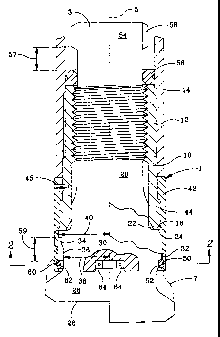Some of the information on this Web page has been provided by external sources. The Government of Canada is not responsible for the accuracy, reliability or currency of the information supplied by external sources. Users wishing to rely upon this information should consult directly with the source of the information. Content provided by external sources is not subject to official languages, privacy and accessibility requirements.
Any discrepancies in the text and image of the Claims and Abstract are due to differing posting times. Text of the Claims and Abstract are posted:
| (12) Patent: | (11) CA 2206169 |
|---|---|
| (54) English Title: | A BIT RETENTION DEVICE FOR A BIT AND CHUCK ASSEMBLY OF A DOWN-THE-HOLE PERCUSSIVE DRILL |
| (54) French Title: | DISPOSITIF DE RETENU POUR TREPAN ET DISPOSITIF D'AJUSTEMENT POUR FORAGE MIS EN OEUVRE AU FOND DU TROU |
| Status: | Expired and beyond the Period of Reversal |
| (51) International Patent Classification (IPC): |
|
|---|---|
| (72) Inventors : |
|
| (73) Owners : |
|
| (71) Applicants : |
|
| (74) Agent: | NORTON ROSE FULBRIGHT CANADA LLP/S.E.N.C.R.L., S.R.L. |
| (74) Associate agent: | |
| (45) Issued: | 2005-11-22 |
| (22) Filed Date: | 1997-05-26 |
| (41) Open to Public Inspection: | 1997-12-10 |
| Examination requested: | 2002-05-24 |
| Availability of licence: | N/A |
| Dedicated to the Public: | N/A |
| (25) Language of filing: | English |
| Patent Cooperation Treaty (PCT): | No |
|---|
| (30) Application Priority Data: | ||||||
|---|---|---|---|---|---|---|
|
A bit retention device for a bit and chuck assembly of a down-the-hole, percussive drill, for retaining a head section of a bit should the head section separate from a shank of the bit includes a chuck adapted for threadable connection to a drill casing, a drill bit, a bit retaining shoulder in the the assembly; a wear collar concentric about the chuck and bit and a flexible retaining member removably connected to the assembly, the retaining member extending radially between the wear collar and bit a sufficient distance to contact the retaining shoulder should the bit drop axially downwardly.
Un dispositif de rétention de trépan pour un ensemble de trépan et de mandrin d'une foreuse fond de trou à percussion, pour retenir une partie de tête d'un trépan si la partie de tête se sépare d'une tige du trépan, comprenant un mandrin adapté pour être raccordé par vissage à un tubage de foreuse, un trépan de foreuse, un épaulement de retenue de trépan dans l'ensemble ; une bague d'usure concentrique au mandrin et au trépan et un élément de retenue flexible relié de manière amovible à l'assemblage, l'élément de retenue s'étendant radialement entre la bague d'usure et le trépan d'une distance suffisante pour communiquer avec l'épaulement de retenue si le trépan tombe axialement vers le bas.
Note: Claims are shown in the official language in which they were submitted.
Note: Descriptions are shown in the official language in which they were submitted.

2024-08-01:As part of the Next Generation Patents (NGP) transition, the Canadian Patents Database (CPD) now contains a more detailed Event History, which replicates the Event Log of our new back-office solution.
Please note that "Inactive:" events refers to events no longer in use in our new back-office solution.
For a clearer understanding of the status of the application/patent presented on this page, the site Disclaimer , as well as the definitions for Patent , Event History , Maintenance Fee and Payment History should be consulted.
| Description | Date |
|---|---|
| Time Limit for Reversal Expired | 2017-05-26 |
| Letter Sent | 2016-05-26 |
| Letter Sent | 2009-01-23 |
| Inactive: IPC from MCD | 2006-03-12 |
| Inactive: IPC from MCD | 2006-03-12 |
| Grant by Issuance | 2005-11-22 |
| Inactive: Cover page published | 2005-11-21 |
| Pre-grant | 2005-09-09 |
| Inactive: Final fee received | 2005-09-09 |
| Notice of Allowance is Issued | 2005-03-09 |
| Letter Sent | 2005-03-09 |
| Notice of Allowance is Issued | 2005-03-09 |
| Inactive: Approved for allowance (AFA) | 2005-02-28 |
| Letter Sent | 2002-07-09 |
| Request for Examination Requirements Determined Compliant | 2002-05-24 |
| Request for Examination Received | 2002-05-24 |
| Amendment Received - Voluntary Amendment | 2002-05-24 |
| All Requirements for Examination Determined Compliant | 2002-05-24 |
| Inactive: Cover page published | 1999-10-06 |
| Application Published (Open to Public Inspection) | 1997-12-10 |
| Inactive: IPC assigned | 1997-09-05 |
| Classification Modified | 1997-09-05 |
| Inactive: IPC assigned | 1997-09-05 |
| Inactive: First IPC assigned | 1997-09-05 |
| Inactive: Correspondence - Prosecution | 1997-09-03 |
| Amendment Received - Voluntary Amendment | 1997-09-03 |
| Inactive: Filing certificate - No RFE (English) | 1997-08-04 |
| Letter Sent | 1997-08-04 |
| Application Received - Regular National | 1997-08-01 |
There is no abandonment history.
The last payment was received on 2005-05-05
Note : If the full payment has not been received on or before the date indicated, a further fee may be required which may be one of the following
Patent fees are adjusted on the 1st of January every year. The amounts above are the current amounts if received by December 31 of the current year.
Please refer to the CIPO
Patent Fees
web page to see all current fee amounts.
Note: Records showing the ownership history in alphabetical order.
| Current Owners on Record |
|---|
| ATLAS COPCO SECOROC LLC |
| Past Owners on Record |
|---|
| WILLIAM LESLIE JONES |